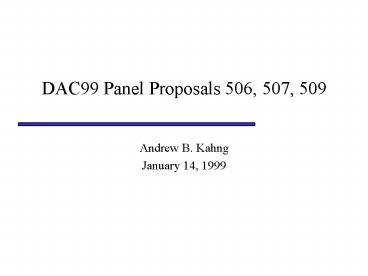DAC99 Panel Proposals 506, 507, 509 PowerPoint PPT Presentation
Title: DAC99 Panel Proposals 506, 507, 509
1
DAC99 Panel Proposals 506, 507, 509
- Andrew B. Kahng
- January 14, 1999
2
Cell Libraries - Build vs. Buy, Static vs. Fluid
- Background
- cell libraries determine ASICdie size,
performance, power - factors routing access/pitch, drive strengths,
common logic functions, - choices silicon vendor (cost, comfort),
3rd-party (migration, better capacity-to-cost),
internal (control, as well as project-specific,
on-the-fly) - key questions (1) pros and cons of different
libraries, library sources? (2) technical and
business criteria for library strategy? (3)
business and technology trends that will
change/improve libraries in future? - interests users, library vendors, silicon
vendors, silicon foundries, EDA - Structure
- (10) moderator cell libraries role in design
flow alternatives - (35) panelists best source of libraries for
different customer types own library strategy
what to consider/measure in selecting library - (30) moderated discussion (15) audience QA
3
Cell Libraries - Build vs. Buy, Static vs. Fluid
- Panel Composition
- Organizer Emil Girzcyc, ex-Cadabra
- Moderator Kurt Keutzer, UC Berkeley
- Jeff Lewis VP Mktg, Artisan ((free) library
vendor) - Martin Lefebvre President, Cadabra (build your
own library to fit product) - Kurt Wolf Dir Mktg for EDA / library
relationships, TSMC (foundry) - Tony Waitz Dir Library Development, Synopsys
(service EDA tools i/f) - Jeff Burns IBM Austin (dynamic, on-the-fly
libraries for max perf) - Dave Pietromonaco Eng Mgr internal cell library
group, HP (system house) - Jay Maxey MTS, TI (silicon vendor provides
process-tuned lib, correctness)
4
Design-Manufacturing Interface in DSM Era Is
Tech-Independent Design Dead?
- Background
- process capability (gates, interconnect) must be
abstracted, consistent with design parameters and
complexity of (e.g., SOC) design tasks - factors reuse and increasing role of foundries
for complex SOCs shrinking design and yield
ramp-up times (TTM) reality of design and
showstoppers in design for leading-edge
technologies - key questions (1) how to design cell/IP
libraries? (2) design for a technology that is
being developed? (3) what design flow minimizes
iterations? (4) can one design robustly enough
to be immune to technology changes? (5) how to
take interconnect into account in SOC? - interests IDMs, ASIC, foundries, fabless, CAD
5
Design-Manufacturing Interface in DSM Era Is
Tech-Independent Design Dead?
- Structure
- (30) moderator and panelists 5-minute
statements of perspectives - designer (both SOC and high-perf microprocessor)
- foundry (hand-off issues)
- 3rd-party library vendor (process-specific cell
library design) - analysis tool vendor (interconnect challenges)
- process modeling, yield learning (examples of
des-mfg I/F in action) - (60) moderated and audience Q/A
6
Design-Manufacturing Interface in DSM EraIs
Tech-Independent Design Dead?
- Panel Composition
- Organizer and Moderator Andrzej Strojwas, CMU
- Joseph Borel Exec VP RD, ST Microelectronics
(requirements for SOC and concurrent technology /
library design issues) - M. Kakumu GM, Custom LSI/ASIC Div, Toshiba
(interplay (e.g., yield ramping) between design
and process) - John Kibarian Pres/CEO, PDF Solutions (real-life
yield ramp / des cycle) - Resve Saleh Chaiman, Simplex (role of
interconnect in design cycle) - Mark Templeton Pres/CEO, Artisan (need to tune IP
libs to DSM process) - Ping Yang VP Design Services, TSMC (foundry
viewpoint, design rule reqs for conservative and
aggressive design scenarios)
7
Parasitic Extraction Accuracy How Much Is
Enough?
- Background
- how does the designer choose the parasitic
extraction solution that is best for the design?
where should effort be spent? - example perspectives
- 3-D, silicon-exact accuracy is always essential
- accuracy requirement is determined by the overall
design process and is less than you think - methodology (e.g., net filtering from upstream
analyses) efficiently provides the required
accuracy - key questions (1) how much accuracy is really
necessary? (2) how to reconcile accurate
extraction with process variations? (3) where
is/should parasitic extraction be used and how
important are speed, resource reqs? (4) other
(inductance? relative vs. absolute? floating
vs. grounded? ) - Structure
- short statements (background, perspective as to
key issues), mostly Q/A
8
Parasitic Extraction Accuracy How Much Is
Enough?
- Panel Composition
- Organizers Mark Basel, Cadence and Paul
Franzon, NCSU - Moderator Paul Franzon, NCSU
- Mark Basel Architect, Cadence (what is the
meaning of accuracy? larger picture combination
with other analyses in a PV methodology) - Ron Preston Circuit designer, Compaq Alpha
(extraction requirement from circuit designers
perspective) - Robin Sarma TCAD support, TI DSP group (absolute
accuracy is not the only way to achieve desired
results - Marty Walker VP Eng, Frequency (accurate
extraction is essential) - Sharad Mehrotra CAD RD, IBM Austin (captive CAD
perspective)

